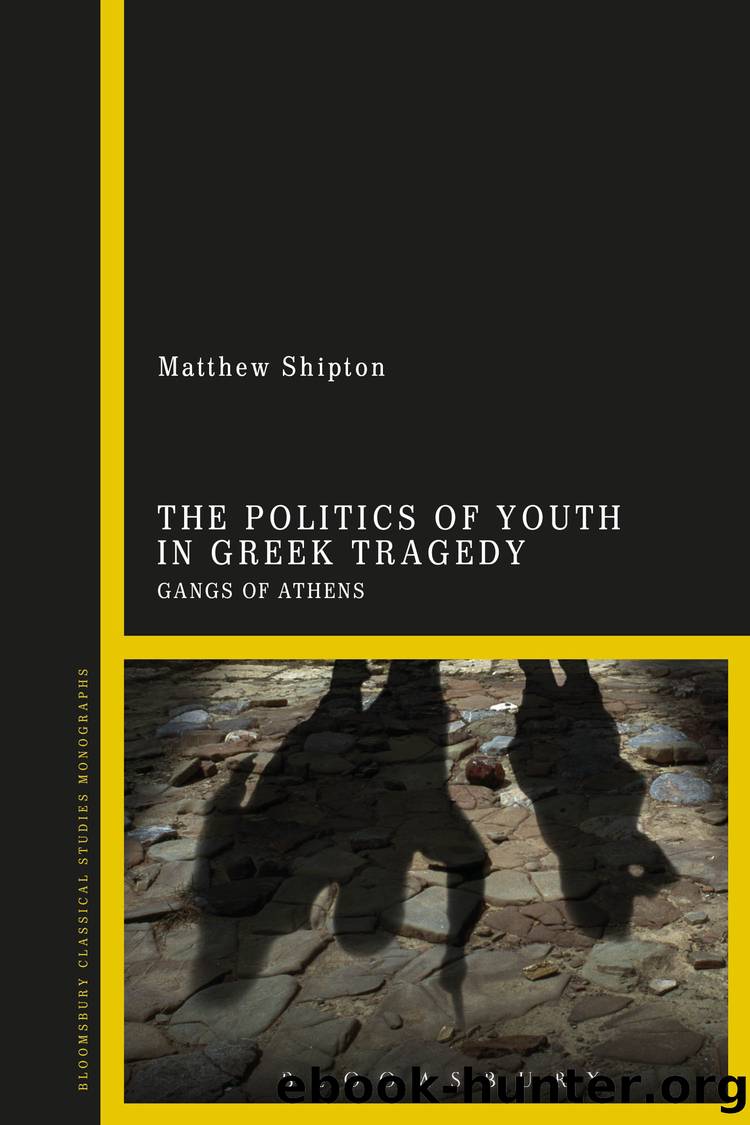The Politics of Youth in Greek Tragedy by Matthew Shipton;

Author:Matthew Shipton; [Shipton, Matthew]
Language: eng
Format: epub
ISBN: 9781474295086
Publisher: Bloomsbury UK
Published: 2017-12-26T00:00:00+00:00
6
Friendship and Generational Loyalty in Euripidesâ Orestes
So far, weâve seen how the plotlines of extant tragedy are taken from a wide variety of myths (and in one case, Persae, directly from historical events) but there are two dominant clusters that are repeatedly drawn upon. The first is those stories associated with Thebes and the family of Oedipus. The second is the myth of the Atreidai. This second group is particularly important for discussion of how Athenian tragedy is shaped by historical events due to the precedent set early in tragedyâs history, in Aeschylusâ highly political Oresteia, that established Orestesâ association with Athens and the cityâs political institutions.1 Sophoclesâ Electra and Euripidesâ Orestes, Electra, Iphigenia at Tauris and Iphigenia at Aulis all cover events relating to the Atreidai and, through the admittedly patchy evidence available, look likely to have been written towards the end of these tragediansâ careers.2 Mining the same vein of myth, it is unsurprising that these plays display similarities in plotline. In all except Iphigenia in Aulis, a central triadic relationship between two young men and a woman results in conflict that ends, or threatens to end in murder. There are striking similarities in the relationships between these playsâ principal characters, the alliances they form in the face of adversity and their preparedness to use violence to achieve their aims. Foremost in this group, it is perhaps Euripidesâ Orestes that presents the most interesting picture of youth in tragedy. This is a play that not only makes a highly innovative departure from the myth of the house of Atreus but features three young characters who form an exclusive group in order to implement a highly aggressive plot.
Between the restoration of democracy in 410 and the Athenian defeat at Notium in 406, a renewed sense of confidence seems to have been established in the city (albeit beginning with a period of political recriminations and show trials). Historical sources for 408 do not reveal any new tensions at Athens, other than those noted in the previous chapter on the different views on how aggressively the Athenian imperial strategy should be pursued and there appears to be relative social and political continuity, if not stability. While the supporters of the oligarchic revolution had been defeated politically, the networks of influence that sustained oligarchic sympathies in Athens would have persisted. One visible manifestation of this network were the hetairiai â often glossed as âclubsâ â perceived after 411 as associations for oligarchic conspirators.3 The most well-known picture of hetairiai is sketched in Thucydides, at 8.65. There, he records: âSome of the younger men had formed a group amongst themselves and had murdered a certain Androcles â¦â. The description of an exclusive group, created in order to carry out violence, appears earlier in Thucydidesâ work, at 3.82, when he describes that membership of a hetairiai (hetairias) required loyalty to your peer group rather than kinship in times of civil war. The reference in Book 8 makes specific mention of the group formed by
Download
This site does not store any files on its server. We only index and link to content provided by other sites. Please contact the content providers to delete copyright contents if any and email us, we'll remove relevant links or contents immediately.
| Anthropology | Archaeology |
| Philosophy | Politics & Government |
| Social Sciences | Sociology |
| Women's Studies |
Cecilia; Or, Memoirs of an Heiress — Volume 1 by Fanny Burney(32434)
Cecilia; Or, Memoirs of an Heiress — Volume 2 by Fanny Burney(31869)
Cecilia; Or, Memoirs of an Heiress — Volume 3 by Fanny Burney(31852)
The Great Music City by Andrea Baker(31340)
We're Going to Need More Wine by Gabrielle Union(18967)
All the Missing Girls by Megan Miranda(15564)
Pimp by Iceberg Slim(14393)
Bombshells: Glamour Girls of a Lifetime by Sullivan Steve(13972)
Talking to Strangers by Malcolm Gladwell(13222)
Norse Mythology by Gaiman Neil(13204)
Fifty Shades Freed by E L James(13157)
For the Love of Europe by Rick Steves(12939)
Mindhunter: Inside the FBI's Elite Serial Crime Unit by John E. Douglas & Mark Olshaker(9198)
Crazy Rich Asians by Kevin Kwan(9167)
The Lost Art of Listening by Michael P. Nichols(7406)
Enlightenment Now: The Case for Reason, Science, Humanism, and Progress by Steven Pinker(7228)
The Four Agreements by Don Miguel Ruiz(6630)
Bad Blood by John Carreyrou(6552)
Weapons of Math Destruction by Cathy O'Neil(6142)
